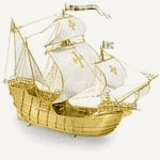Project History
Every industry has its concentrations of activity. Jewelers Row in Philadelphia is one such intersection of commerce and creativity, a conjunction of showroom and workroom. The wares of these few city blocks may end up anywhere on the map, but the district itself is a very small world: on the day we visited, everyone knew that Antonio had gotten "the boats" out. A steady stream of people dropped by his studio to see them. After all, it had been a year and a half since the ships had last been out of the bank vault. It was an event.
First Glimpse
The studio wasn't glamorous. The calendar on the wall said December (it was mid-summer). The worktable was littered with weights and tools, with scraps of gold, crucibles doubling as ashtrays. On one end of the studio stood a row of windows; on the other end, the ships. The side of the room with the ships was brighter. The sunlight, in fact, looked downright drab in comparison. The ships seemed not to merely catch light but to emit it, like a light source. Antonio handled them with the greatest care - as if they were sleeping and might wake up. We never held them: he didn't offer it, and we didn't ask.
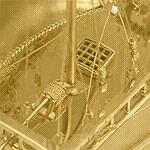
Such a Cost
Goldsmithing is not like most activities - you can't just do it anytime. First, you've got to have the gold. Antonio insisted on ships of solid gold and platinum. There is no other material except these two precious metals to be found on any of the works, not even in the solder. For nearly two decades, Antonio knew he wanted to build Columbus's ships in gold, but the sheer expense stopped him. The approach of the voyage's 500th anniversary, however, made Antonio's plan just timely enough, and in the late 1980s he found enough investors to finance the project. There were two major expenses - the precious metal itself, and the unpaid time that Antonio would be foregoing other work to concentrate on the ships. He estimated that the job would take him a year and a half. It took him much longer...

The Perfect Man for the Job
In Madrid, where Antonio was born, there are pine trees with unusually thick bark; as a child, he would hollow out a small section of this bark and work it into the shape of a boat. If it proved unseaworthy in the family tub, he added a washer off a seltzer bottle's top for ballast. Antonio would have most likely become an auto mechanic, like his father, but was instead apprenticed to a jeweler. He brought his goldsmithing skills to Philadelphia's famed Jewelers Row, where his unique designs - intricate yet controlled - made him a sought after creator of custom rings, pendants, and bracelets. But through the years, Antonio continued to build boats as well - wooden replicas of historic vessels, remarkable for their attention to detail and faithfulness to actual ship design. A master of two disparate crafts, Antonio united his talents to create the Golden Ships of Columbus.
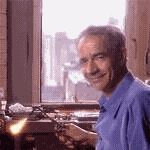
The Work Before the Work
The ships' construction was preceded by a year of preparatory work. During that time, Antonio had studied his blueprint...and concluded that he didn't have the tools. In fact, no one did - they didn't exist. This is one of the hazards of being the first: no one had ever attempted such a project. Now, Antonio is of course a goldsmith, but in a broader sense he is a designer, so he took it upon himself to custom design the tools he needed. For example, he created a hammer with a hook-shaped head - a hammer, in effect, that could hammer around a corner - to work the surface within the curved interior of the hull.
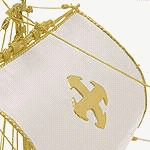
Ingenuity
Antonio needed to create an incision running the length of a section of hollow gold wire. The wire would be fitted to the edges of the ships' sails, somewhat like a frame. Only the narrowest cut was required, just enough for the wire to grasp the edge of the paper-thin sail like a tightly shut mouth. For this shallowest of incisions, a lathe capable of minute movement and great steadiness was required. Antonio's design (left) included a few two-by-fours, a fishing rod, a door hinge, and the transmission from a vacuum cleaner. From such items, he fashioned a high-precision instrument. The one-of-a-kind lathe was also used to cut the ships' hulls: their curvature made a smooth cut especially difficult, but the sensitive, floating arm of Antonio's lathe followed the hulls' curves perfectly.
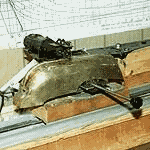
Finding Your Strength
Before proceeding with construction, Antonio went through a "dry run," using brass. Brass isn't necessarily any easier to work with, but it's a good deal less expensive. Antonio built brass versions of the ships' various pieces, including all three hulls. The hulls are the foundations of the ships, the largest pieces and the most difficult to build. Their difficulty lay in their curvature. Antonio heated these large pieces of gold again and again, gradually working them into the properly curved form. Because the gold became more and more vulnerable as he progressed, he only had so much room to work with; the heat should make the metal bendable, after all, not melt it. Overdo the heat and suddenly you're no longer smithing, you're minting
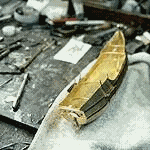
Casting Off
Construction began in 1989. The first ship to be built was the largest - the flagship, the Santa Maria. He knew it would require the most time. This was partly because of the ship's intricate detail. But more importantly, as the first to be built, it would reveal the project's difficulties. The solutions could be applied to the other, smaller ships, which could then be built more quickly. Starting in on the Santa Maria must have been as daunting as it was exciting: Antonio knew that an awesome job lay ahead of him. It turned out to be far more difficult than he could have ever guessed.
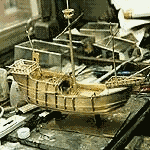
Home At Last
The quincentennial came and went. Antonio pressed on. When he finally looked up from his work, he found that four years had gone by since construction had begun. In that time, he had taken on no other work. Often he stayed at home, where he worked six days a week. (Long days - in estimating the cost of labor, the appraisal sets the figure at 9,750 hours.) From the beginning, he had held an image in his mind of what the ships would look like finished. There were no surprises in their construction: they represent a complete follow-through on conception, the pure transformation of thought into object. So it was no decision when Antonio declared the ships "done" - it was a simple recognition that all was in place. There was nothing left to do.
